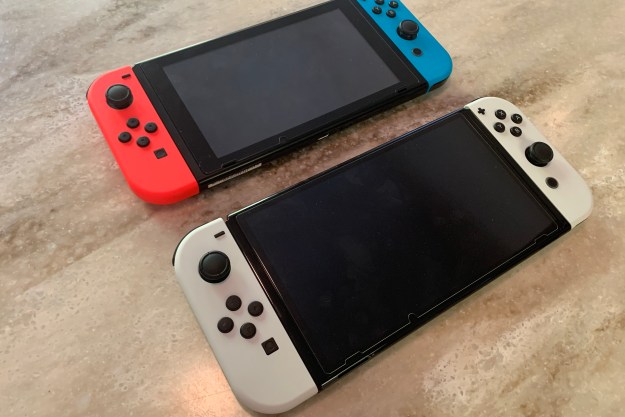“WiFi gaming capabilities and fun camera and sound activities make the DSi a welcome upgrade for most Nintendo fans.”
- Intuitive to use; fun multimedia options; slick WiFi gaming; online shop
- Weak camera; no editing of non-DSi photos; lacks GameBoy Advance support; limited music compatibility
Summary
Nintendo isn’t known for upgrading systems without reason, and the new DSi adds considerable power to the company’s handheld line. Fresh features like brighter/bigger screens, Secure Digital (SD) Memory card support and twin digital cameras prove cool introductions, just to start. But the system’s real strength comes in its downloadable games shop – something that might help players forget about the unit’s dropped GameBoy Advance support, and the fact it’ll be a mostly optional purchase for current DS owners.

The Nintendo DSi isn’t too different from its predecessors in both design and shape. A horizontal build, the DSi is five and a half inches by three inches when open, and just under an inch thick when closed. The clamshell case, now boasting a matte finish, has dual screens – one on each half. It weighs about eight ounces, or twice the weight of the average smartphone, but still less than the competing Sony PSP. The two colors available are pitch black and baby blue.
When open, the top half of the unit features the primary play screen, and the middle band between halves boasts three new indicators – active wireless, active plug and active power. The middle band also hides two other handy items – a small mic and a pinhole camera. The bottom half incorporates the second display (a finger-/stylus-ready touchscreen) with a directional keypad located to its left and four action buttons, as well as start and select keys, to the right. The power button – on the right flank of the previous DS – is now located an inch below the keypad.
The unit’s sides are less busy than those found in the previous model. The left-hand side hosts the volume buttons. The right-hand side has a hole for your stylus and, as a new feature, an SD memory card slot. Close the shell and, on the top side, you’ll see a second pinhole camera. The front has a typical headphone jack hole, but alongside it is a rectangular slot, a la the one found on Sony’s PSP, presumably for future proprietary headphones or gear. The very back of the system has a cartridge slot, a power plug hole and a shoulder button on either side.
Existing DS owners will immediately note that Nintendo removed the GameBoy Advance slot, which proves somewhat disappointing. This slot enabled previous models such as the DS Lite to play older GBA games and make use of titles like Guitar Hero: On Tour’s mock music controllers, which plugged into the port, presumably to make room for a memory card.

Nintendo DSi
Setup & Use
The DSi package comes with a few items inside. In the box are the system, the wall plug, an extra stylus (one is already packed inside the system) and a heavyweight instruction book with a small, quick start guide attached.

The initial screens ask for your nickname, location and other details. It also opens a parental controls screen so you may censor objectionable content from the kiddies.
Once past the formalities, the DSi opens to a Wii-style hub with seven icons – camera, sound, shop, download play, PictoChat, system settings and current game. The icons are selected by a quick double-tap of the stylus.
The camera is immediately available by pressing the left or right shoulder buttons. The top screen is a pic holder, while the bottom screen is a “live” feed – or, in other words, a viewfinder. The viewfinder has icons to take a picture or to switch between the two camera lenses in the front and on the top of the DSi. (One faces outward for taking pictures of others, one inward for snapping images of yourself.) Once a shot is taken, it can be brought into the DSi Camera area, a laboratory where you can look at the snapshots taken with the DSi and modify them using a built-in photo editing suite.
You can do basic editing, but the real depth here comes in using the eleven different treatments said utilities package offers such as distortion, in which the stylus can be use to mold picture elements like putty, or the freaky-looking merge, in which a photo of two people’s faces are merged into a silly hybrid of both. At a piddling 640×480 resolution, these pics won’t wind up in an actual photo frame, but look decent enough on the system’s screen, while creating distorted photos proves simple, fun and mildly addictive, in much the same way as it does with those goofy photo booths popular in Tokyo.

The DSi download shop and DS download play – two new options for the DSi – feature purchasable software and demos, respectively, beamed via WiFi. Download play also allows gaming against other DS users with only one cartridge necessary. PictoChat has not changed much since the original DS – users can draw pictures and send text messages to friends within range.
Finally, from the DSi system settings, you can modify the wireless connection, brightness and about a dozen other defaults. Nintendo estimates that the keeping the DSi’s brightness level at 5, the highest, will net up to 4 hours of continuous play, while level 1, the dimmest setting, will net up to 14 hours of continuous play. The number is significantly higher than the Sony PSP and a slight improvement from the original DS.
The positive of the weak, 0.3 MegaPixel camera is that the DSi memory can hold hundreds of photos. Unlike other camera-enabled devices, the memory card isn’t necessary from the start. However, transferring photos to other mediums, such as another camera or a computer, will require a card.
Price
The Nintendo DSi is $169.99 MSRP, equal to the Sony PSP 3000 Core Pack and $40 more than the previous DS Lite. Through October 5, 2009, Nintendo is offering 1000 free Nintendo points – approximately $10 credit – if you use the DSi to log onto the download shop (more details are at http://dsioffer.nintendo.com). Consider spending additional money on an SD memory card, though a smaller card size should do just fine. A WiFi connection is definitely required to get the most out of the system. It plays all the previous DS games, but there are downloadable games exclusive to the DSi. More information is at http://www.nintendo.com/ds.
Future Prognosis
While the DS Lite basically shrunk the original DS, the DSi is a bigger evolution in the DS series. The WiFi gaming capabilities and fun camera and sound activities outweigh the loss of Game Boy Advance support, making the DSi a welcome upgrade for most Nintendo fans, though not a mandatory purchase if money’s tight. Those who haven’t invested previously in a handheld system should seriously consider paying the premium, however, as added enhancements more than justify the higher asking price.
Pros:
- Intuitive to use
- Fun multimedia options
- Slick WiFi gaming
- Online shop
Cons:
- Weak camera
- No editing of non-DSi photos
- Dropped Game Boy Advance support
- Limited music compatibility
Editors' Recommendations
- Best video game deals: PlayStation 5, Xbox S and X, Nintendo Switch
- The best cozy games
- All cross-platform games (PS5, Xbox Series X, PS4, Xbox One, Switch, PC)
- 10 best gaming monitors of 2024: tested and reviewed
- Nintendo Switch 2: release date rumors, features we want, and more






